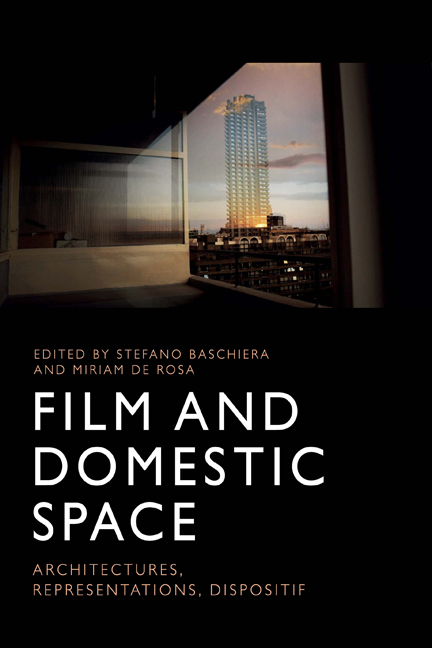Book contents
- Frontmatter
- Contents
- List of Figures
- Notes on the Contributors
- Acknowledgements
- Introduction
- 1 Architectures of Ubiquity: The Colonial Revival in Film and Television
- 2 No Down Payment: Whiteness, Japanese American Masculinity and Architectural Space in the Cinematic Suburbs
- 3 Resist, Redefine, Appropriate: Negotiating the Domestic Space in Contemporary Female Biopics
- 4 Liminal Spaces, Lesbian Desire and Veering off Course in Todd Haynes’s Carol
- 5 A Home on the Road in Claire Denis’s Vendredi soir
- 6 Acoustic Ectoplasm and the Loss of Home
- 7 Our House Now: Flat and Reversible Home Spaces in Post-war Film and Television
- 8 From Myth to Reality: Images of Domestic Space in Post-Soviet Baltic Films
- 9 No | Home | Movie: Essay Film, Architecture as Framing and the Non-house
- 10 At Home with the Nouvelle Vague: Apartment Plots and Domestic Urbanism in Godard’s Une femme est une femme and Varda’s Cléo de 5 à 7
- 11 Dwelling the Open: Amos Gitai and the Home of Cinema
- 12 What Is Cult When It’s At Home? Reframing Cult Cinema in Relation to Domestic Space
- 13 High-fructose Cinema and the Movie Industrial Complex: Radicalising the Technology of Representation in a Domestic Kind of Way
- Index
11 - Dwelling the Open: Amos Gitai and the Home of Cinema
Published online by Cambridge University Press: 22 September 2020
- Frontmatter
- Contents
- List of Figures
- Notes on the Contributors
- Acknowledgements
- Introduction
- 1 Architectures of Ubiquity: The Colonial Revival in Film and Television
- 2 No Down Payment: Whiteness, Japanese American Masculinity and Architectural Space in the Cinematic Suburbs
- 3 Resist, Redefine, Appropriate: Negotiating the Domestic Space in Contemporary Female Biopics
- 4 Liminal Spaces, Lesbian Desire and Veering off Course in Todd Haynes’s Carol
- 5 A Home on the Road in Claire Denis’s Vendredi soir
- 6 Acoustic Ectoplasm and the Loss of Home
- 7 Our House Now: Flat and Reversible Home Spaces in Post-war Film and Television
- 8 From Myth to Reality: Images of Domestic Space in Post-Soviet Baltic Films
- 9 No | Home | Movie: Essay Film, Architecture as Framing and the Non-house
- 10 At Home with the Nouvelle Vague: Apartment Plots and Domestic Urbanism in Godard’s Une femme est une femme and Varda’s Cléo de 5 à 7
- 11 Dwelling the Open: Amos Gitai and the Home of Cinema
- 12 What Is Cult When It’s At Home? Reframing Cult Cinema in Relation to Domestic Space
- 13 High-fructose Cinema and the Movie Industrial Complex: Radicalising the Technology of Representation in a Domestic Kind of Way
- Index
Summary
For the past is the foundation,
And by destroying the foundation the building collapses. (Efratia Gitai)
Poetry is what really lets us dwell. (Martin Heidegger)
Landscape is a site of multiplicity, even when it is a domestic one. It is the result of a stratification of trajectories and stories simultaneously cutting across each other, which rearticulate the space containing them according to a set of complex relations. This chapter tries to unravel these complex relations by thinking domestic space with the help of an interdisciplinary approach based on film studies, philosophy and geography. It is in the encounter of these areas that I believe a number of interesting categories to approach domesticity lie, especially if we try to see the home not only as the on-screen stage of representation, a reconstructed or recorded set that is part of a diegetic discourse which cinema films, but also as an off-screen spatial dispositif where moving images are called to inhabit the environment as if that were their home. Whilst most of the existing scholarship feeds the discourse on domestic space as it is represented in films, the latter approach seems less explored. In the following pages I embrace this twofold perspective on the home, in the conviction that a virtuous mutual benefit derives from an analysis that pairs on- and off-screen dimensions. To test such idea and put it into practice, my reflection will be centred on the latter approach, but I will develop my argument by looking at the films by Israeli director Amos Gitai, which portray the home in a variety of ways.
Gitai's interest in domestic space is very clear in films such as House (1980), A House in Jerusalem (1998) and News from Home/News from House (2006), which compose a real ‘home trilogy’. However, a wider and more diverse body of works better suit the twofold methodological perspective I am proposing and testing here. This is why my attention will focus instead on those films which, after a theatrical release, have been employed to build a multimedia multichannel video installation, presented with the title Architectures of Memory in late 2011 in Turin, Italy.
- Type
- Chapter
- Information
- Film and Domestic SpaceArchitectures, Representations, Dispositif, pp. 188 - 209Publisher: Edinburgh University PressPrint publication year: 2020



